Criminal Law Assignment: Durkheim's 'Crime is Normal' Discussion
VerifiedAdded on 2022/11/14
|8
|2154
|329
Essay
AI Summary
This essay critically discusses Emile Durkheim's assertion that "Crime is normal." It explores the functional perspective of crime, arguing that crime and deviance are integral to a healthy society and contribute to social cohesion. The essay delves into structural functionalism, social consensus theory, social disorganization theory, strain theory, and conflict theory to analyze Durkheim's perspective. It examines how crime reinforces social norms, facilitates social change, and highlights the role of punishment in maintaining social order. The paper also touches upon the implications of Durkheim's work on modern criminal justice systems, advocating for approaches that prioritize social harmony and restorative justice, particularly in the context of juvenile justice. The essay concludes by emphasizing the importance of understanding crime as a normal part of society and the need for a positive approach to the criminal justice system.
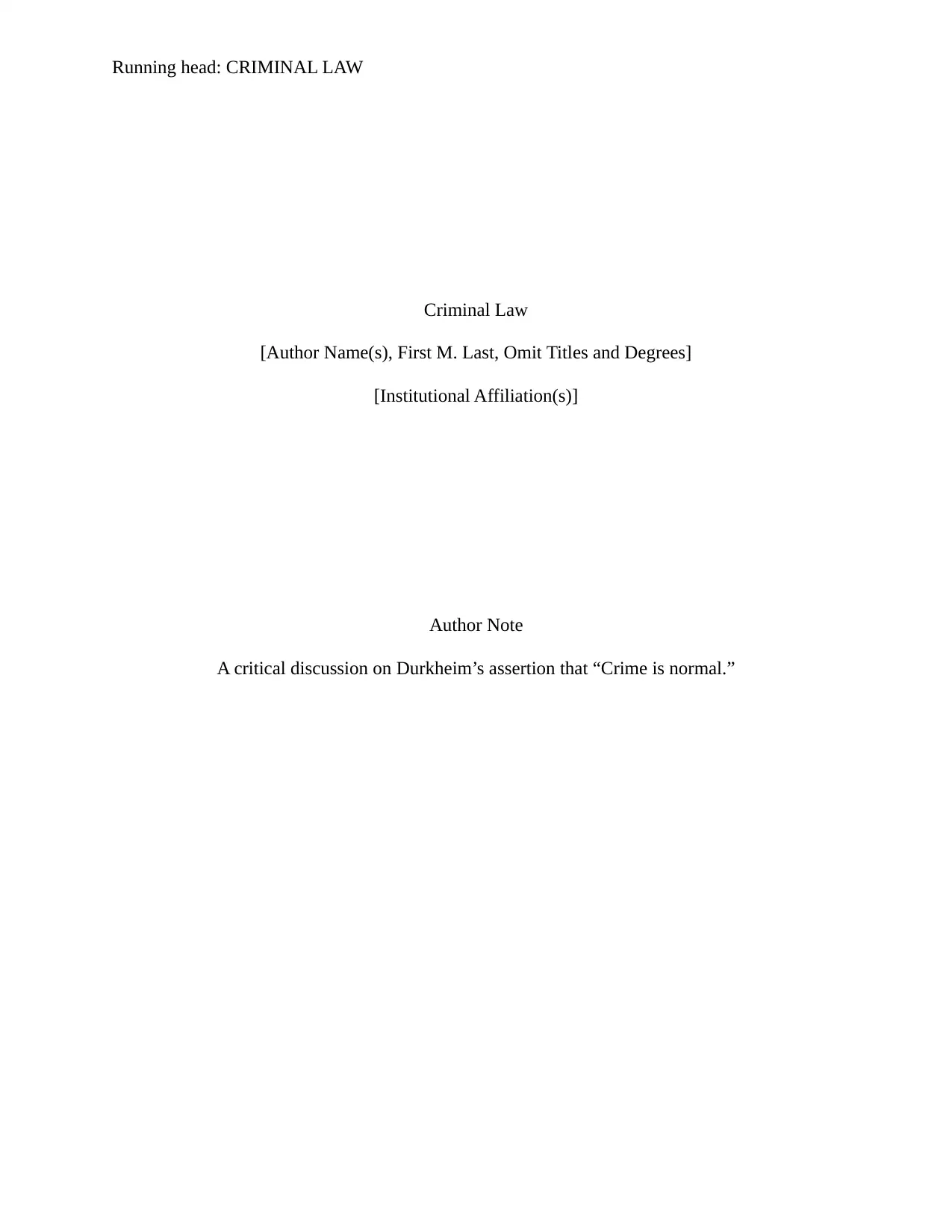
Running head: CRIMINAL LAW
Criminal Law
[Author Name(s), First M. Last, Omit Titles and Degrees]
[Institutional Affiliation(s)]
Author Note
A critical discussion on Durkheim’s assertion that “Crime is normal.”
Criminal Law
[Author Name(s), First M. Last, Omit Titles and Degrees]
[Institutional Affiliation(s)]
Author Note
A critical discussion on Durkheim’s assertion that “Crime is normal.”
Paraphrase This Document
Need a fresh take? Get an instant paraphrase of this document with our AI Paraphraser
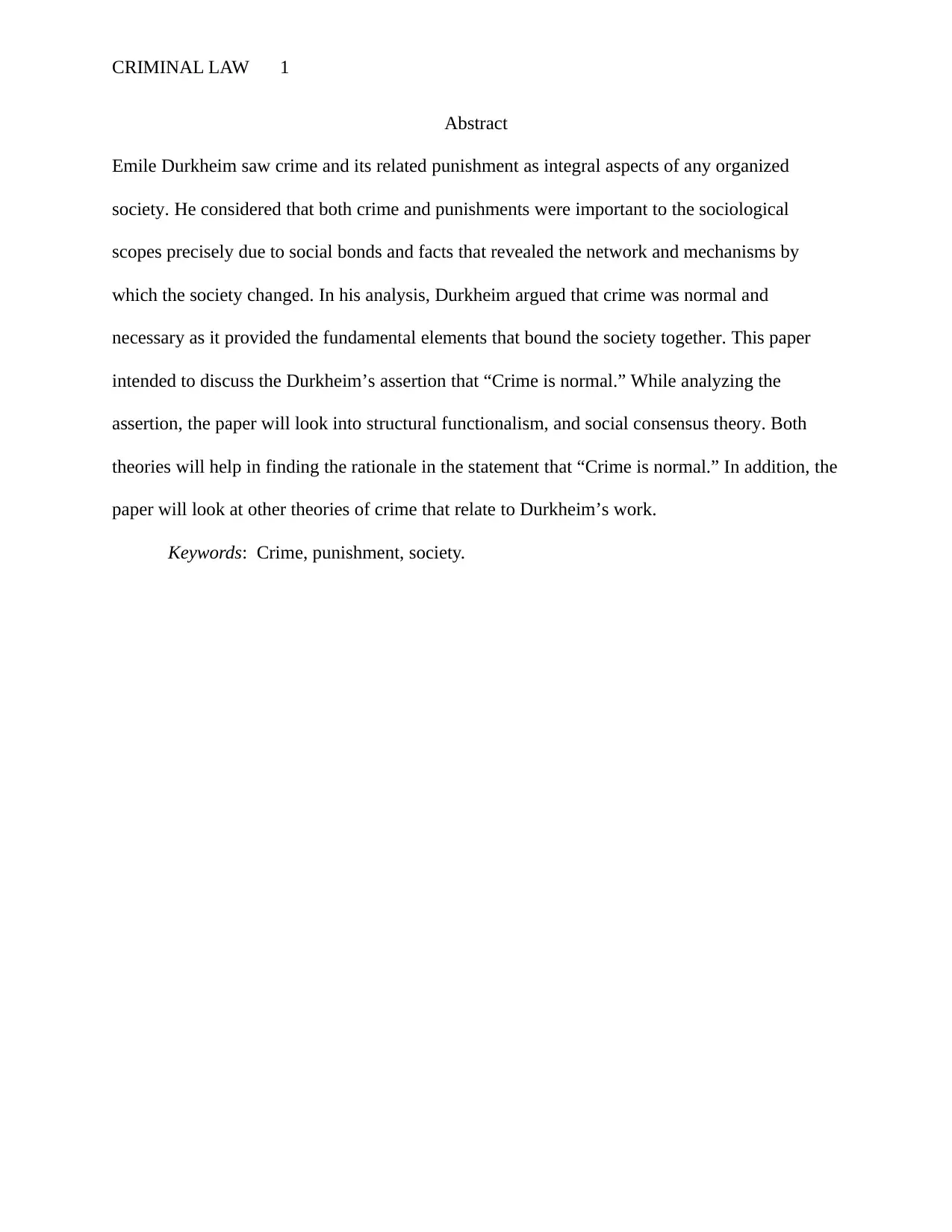
CRIMINAL LAW 1
Abstract
Emile Durkheim saw crime and its related punishment as integral aspects of any organized
society. He considered that both crime and punishments were important to the sociological
scopes precisely due to social bonds and facts that revealed the network and mechanisms by
which the society changed. In his analysis, Durkheim argued that crime was normal and
necessary as it provided the fundamental elements that bound the society together. This paper
intended to discuss the Durkheim’s assertion that “Crime is normal.” While analyzing the
assertion, the paper will look into structural functionalism, and social consensus theory. Both
theories will help in finding the rationale in the statement that “Crime is normal.” In addition, the
paper will look at other theories of crime that relate to Durkheim’s work.
Keywords: Crime, punishment, society.
Abstract
Emile Durkheim saw crime and its related punishment as integral aspects of any organized
society. He considered that both crime and punishments were important to the sociological
scopes precisely due to social bonds and facts that revealed the network and mechanisms by
which the society changed. In his analysis, Durkheim argued that crime was normal and
necessary as it provided the fundamental elements that bound the society together. This paper
intended to discuss the Durkheim’s assertion that “Crime is normal.” While analyzing the
assertion, the paper will look into structural functionalism, and social consensus theory. Both
theories will help in finding the rationale in the statement that “Crime is normal.” In addition, the
paper will look at other theories of crime that relate to Durkheim’s work.
Keywords: Crime, punishment, society.
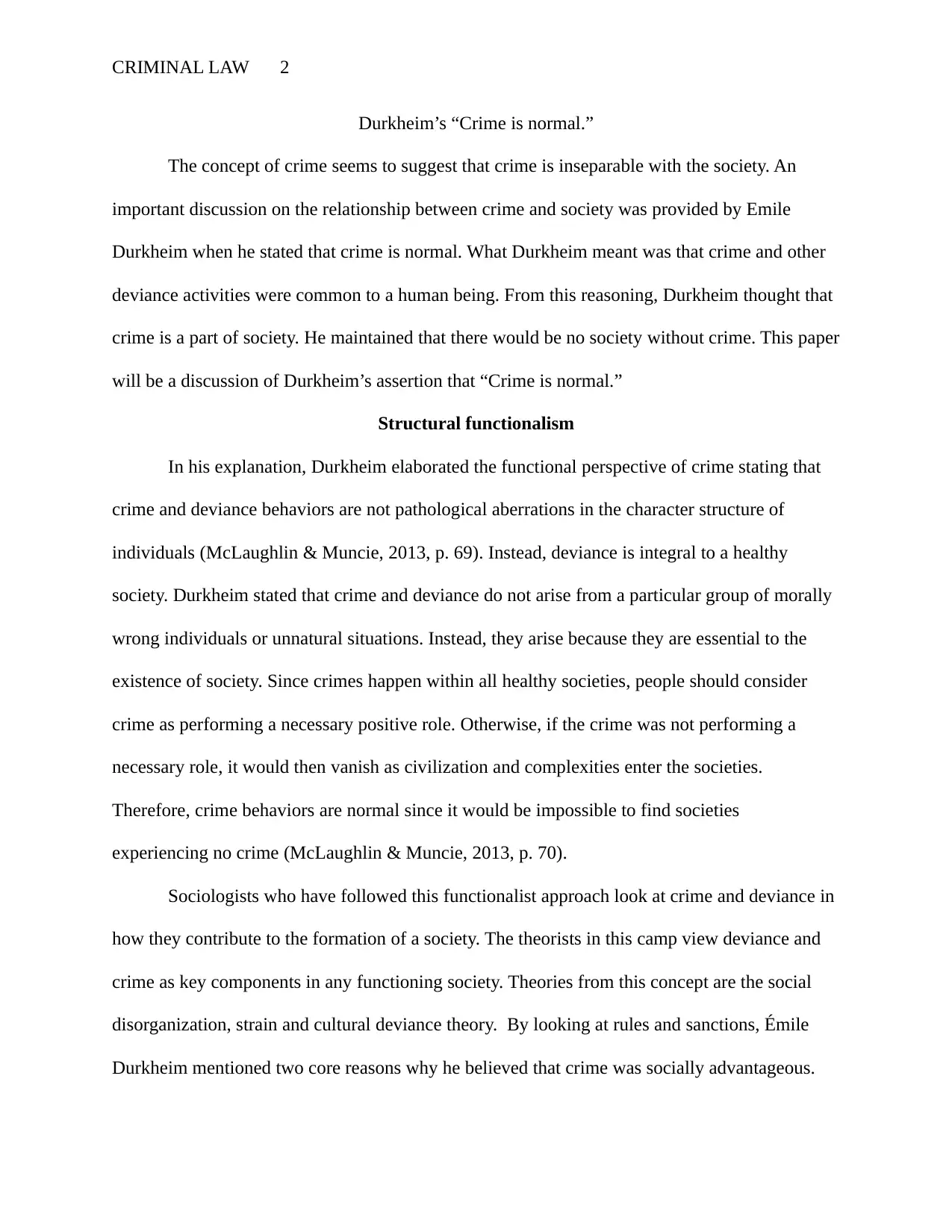
CRIMINAL LAW 2
Durkheim’s “Crime is normal.”
The concept of crime seems to suggest that crime is inseparable with the society. An
important discussion on the relationship between crime and society was provided by Emile
Durkheim when he stated that crime is normal. What Durkheim meant was that crime and other
deviance activities were common to a human being. From this reasoning, Durkheim thought that
crime is a part of society. He maintained that there would be no society without crime. This paper
will be a discussion of Durkheim’s assertion that “Crime is normal.”
Structural functionalism
In his explanation, Durkheim elaborated the functional perspective of crime stating that
crime and deviance behaviors are not pathological aberrations in the character structure of
individuals (McLaughlin & Muncie, 2013, p. 69). Instead, deviance is integral to a healthy
society. Durkheim stated that crime and deviance do not arise from a particular group of morally
wrong individuals or unnatural situations. Instead, they arise because they are essential to the
existence of society. Since crimes happen within all healthy societies, people should consider
crime as performing a necessary positive role. Otherwise, if the crime was not performing a
necessary role, it would then vanish as civilization and complexities enter the societies.
Therefore, crime behaviors are normal since it would be impossible to find societies
experiencing no crime (McLaughlin & Muncie, 2013, p. 70).
Sociologists who have followed this functionalist approach look at crime and deviance in
how they contribute to the formation of a society. The theorists in this camp view deviance and
crime as key components in any functioning society. Theories from this concept are the social
disorganization, strain and cultural deviance theory. By looking at rules and sanctions, Émile
Durkheim mentioned two core reasons why he believed that crime was socially advantageous.
Durkheim’s “Crime is normal.”
The concept of crime seems to suggest that crime is inseparable with the society. An
important discussion on the relationship between crime and society was provided by Emile
Durkheim when he stated that crime is normal. What Durkheim meant was that crime and other
deviance activities were common to a human being. From this reasoning, Durkheim thought that
crime is a part of society. He maintained that there would be no society without crime. This paper
will be a discussion of Durkheim’s assertion that “Crime is normal.”
Structural functionalism
In his explanation, Durkheim elaborated the functional perspective of crime stating that
crime and deviance behaviors are not pathological aberrations in the character structure of
individuals (McLaughlin & Muncie, 2013, p. 69). Instead, deviance is integral to a healthy
society. Durkheim stated that crime and deviance do not arise from a particular group of morally
wrong individuals or unnatural situations. Instead, they arise because they are essential to the
existence of society. Since crimes happen within all healthy societies, people should consider
crime as performing a necessary positive role. Otherwise, if the crime was not performing a
necessary role, it would then vanish as civilization and complexities enter the societies.
Therefore, crime behaviors are normal since it would be impossible to find societies
experiencing no crime (McLaughlin & Muncie, 2013, p. 70).
Sociologists who have followed this functionalist approach look at crime and deviance in
how they contribute to the formation of a society. The theorists in this camp view deviance and
crime as key components in any functioning society. Theories from this concept are the social
disorganization, strain and cultural deviance theory. By looking at rules and sanctions, Émile
Durkheim mentioned two core reasons why he believed that crime was socially advantageous.
⊘ This is a preview!⊘
Do you want full access?
Subscribe today to unlock all pages.

Trusted by 1+ million students worldwide
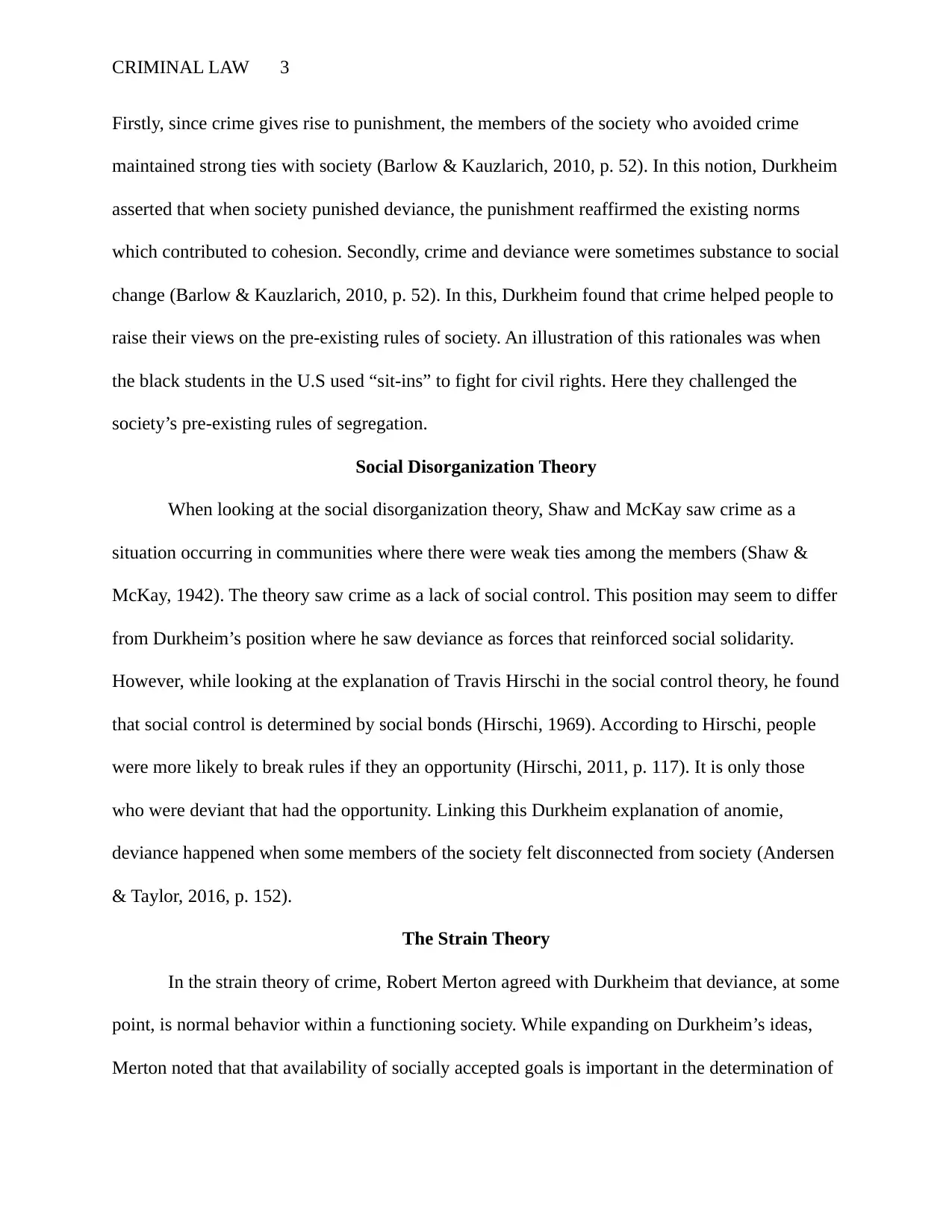
CRIMINAL LAW 3
Firstly, since crime gives rise to punishment, the members of the society who avoided crime
maintained strong ties with society (Barlow & Kauzlarich, 2010, p. 52). In this notion, Durkheim
asserted that when society punished deviance, the punishment reaffirmed the existing norms
which contributed to cohesion. Secondly, crime and deviance were sometimes substance to social
change (Barlow & Kauzlarich, 2010, p. 52). In this, Durkheim found that crime helped people to
raise their views on the pre-existing rules of society. An illustration of this rationales was when
the black students in the U.S used “sit-ins” to fight for civil rights. Here they challenged the
society’s pre-existing rules of segregation.
Social Disorganization Theory
When looking at the social disorganization theory, Shaw and McKay saw crime as a
situation occurring in communities where there were weak ties among the members (Shaw &
McKay, 1942). The theory saw crime as a lack of social control. This position may seem to differ
from Durkheim’s position where he saw deviance as forces that reinforced social solidarity.
However, while looking at the explanation of Travis Hirschi in the social control theory, he found
that social control is determined by social bonds (Hirschi, 1969). According to Hirschi, people
were more likely to break rules if they an opportunity (Hirschi, 2011, p. 117). It is only those
who were deviant that had the opportunity. Linking this Durkheim explanation of anomie,
deviance happened when some members of the society felt disconnected from society (Andersen
& Taylor, 2016, p. 152).
The Strain Theory
In the strain theory of crime, Robert Merton agreed with Durkheim that deviance, at some
point, is normal behavior within a functioning society. While expanding on Durkheim’s ideas,
Merton noted that that availability of socially accepted goals is important in the determination of
Firstly, since crime gives rise to punishment, the members of the society who avoided crime
maintained strong ties with society (Barlow & Kauzlarich, 2010, p. 52). In this notion, Durkheim
asserted that when society punished deviance, the punishment reaffirmed the existing norms
which contributed to cohesion. Secondly, crime and deviance were sometimes substance to social
change (Barlow & Kauzlarich, 2010, p. 52). In this, Durkheim found that crime helped people to
raise their views on the pre-existing rules of society. An illustration of this rationales was when
the black students in the U.S used “sit-ins” to fight for civil rights. Here they challenged the
society’s pre-existing rules of segregation.
Social Disorganization Theory
When looking at the social disorganization theory, Shaw and McKay saw crime as a
situation occurring in communities where there were weak ties among the members (Shaw &
McKay, 1942). The theory saw crime as a lack of social control. This position may seem to differ
from Durkheim’s position where he saw deviance as forces that reinforced social solidarity.
However, while looking at the explanation of Travis Hirschi in the social control theory, he found
that social control is determined by social bonds (Hirschi, 1969). According to Hirschi, people
were more likely to break rules if they an opportunity (Hirschi, 2011, p. 117). It is only those
who were deviant that had the opportunity. Linking this Durkheim explanation of anomie,
deviance happened when some members of the society felt disconnected from society (Andersen
& Taylor, 2016, p. 152).
The Strain Theory
In the strain theory of crime, Robert Merton agreed with Durkheim that deviance, at some
point, is normal behavior within a functioning society. While expanding on Durkheim’s ideas,
Merton noted that that availability of socially accepted goals is important in the determination of
Paraphrase This Document
Need a fresh take? Get an instant paraphrase of this document with our AI Paraphraser
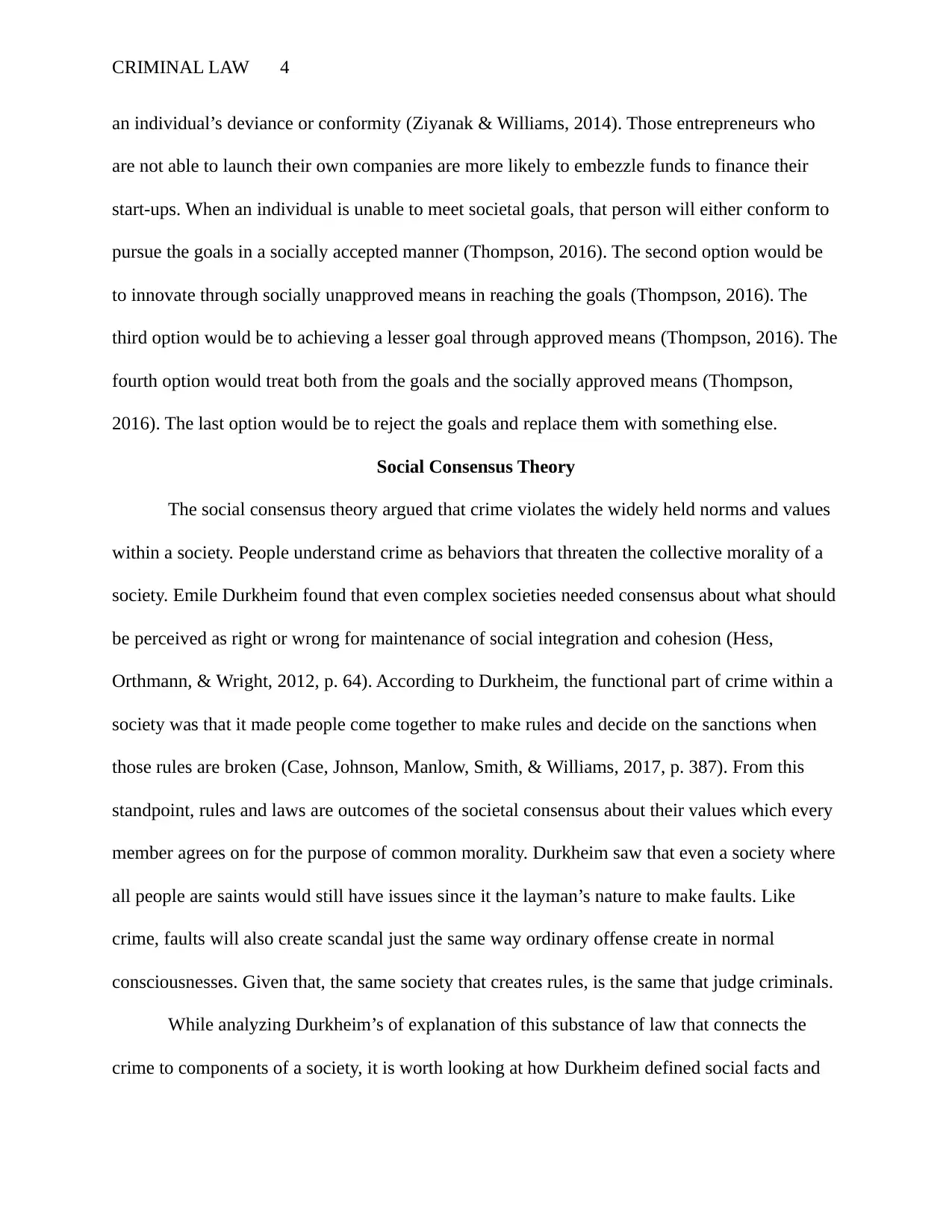
CRIMINAL LAW 4
an individual’s deviance or conformity (Ziyanak & Williams, 2014). Those entrepreneurs who
are not able to launch their own companies are more likely to embezzle funds to finance their
start-ups. When an individual is unable to meet societal goals, that person will either conform to
pursue the goals in a socially accepted manner (Thompson, 2016). The second option would be
to innovate through socially unapproved means in reaching the goals (Thompson, 2016). The
third option would be to achieving a lesser goal through approved means (Thompson, 2016). The
fourth option would treat both from the goals and the socially approved means (Thompson,
2016). The last option would be to reject the goals and replace them with something else.
Social Consensus Theory
The social consensus theory argued that crime violates the widely held norms and values
within a society. People understand crime as behaviors that threaten the collective morality of a
society. Emile Durkheim found that even complex societies needed consensus about what should
be perceived as right or wrong for maintenance of social integration and cohesion (Hess,
Orthmann, & Wright, 2012, p. 64). According to Durkheim, the functional part of crime within a
society was that it made people come together to make rules and decide on the sanctions when
those rules are broken (Case, Johnson, Manlow, Smith, & Williams, 2017, p. 387). From this
standpoint, rules and laws are outcomes of the societal consensus about their values which every
member agrees on for the purpose of common morality. Durkheim saw that even a society where
all people are saints would still have issues since it the layman’s nature to make faults. Like
crime, faults will also create scandal just the same way ordinary offense create in normal
consciousnesses. Given that, the same society that creates rules, is the same that judge criminals.
While analyzing Durkheim’s of explanation of this substance of law that connects the
crime to components of a society, it is worth looking at how Durkheim defined social facts and
an individual’s deviance or conformity (Ziyanak & Williams, 2014). Those entrepreneurs who
are not able to launch their own companies are more likely to embezzle funds to finance their
start-ups. When an individual is unable to meet societal goals, that person will either conform to
pursue the goals in a socially accepted manner (Thompson, 2016). The second option would be
to innovate through socially unapproved means in reaching the goals (Thompson, 2016). The
third option would be to achieving a lesser goal through approved means (Thompson, 2016). The
fourth option would treat both from the goals and the socially approved means (Thompson,
2016). The last option would be to reject the goals and replace them with something else.
Social Consensus Theory
The social consensus theory argued that crime violates the widely held norms and values
within a society. People understand crime as behaviors that threaten the collective morality of a
society. Emile Durkheim found that even complex societies needed consensus about what should
be perceived as right or wrong for maintenance of social integration and cohesion (Hess,
Orthmann, & Wright, 2012, p. 64). According to Durkheim, the functional part of crime within a
society was that it made people come together to make rules and decide on the sanctions when
those rules are broken (Case, Johnson, Manlow, Smith, & Williams, 2017, p. 387). From this
standpoint, rules and laws are outcomes of the societal consensus about their values which every
member agrees on for the purpose of common morality. Durkheim saw that even a society where
all people are saints would still have issues since it the layman’s nature to make faults. Like
crime, faults will also create scandal just the same way ordinary offense create in normal
consciousnesses. Given that, the same society that creates rules, is the same that judge criminals.
While analyzing Durkheim’s of explanation of this substance of law that connects the
crime to components of a society, it is worth looking at how Durkheim defined social facts and
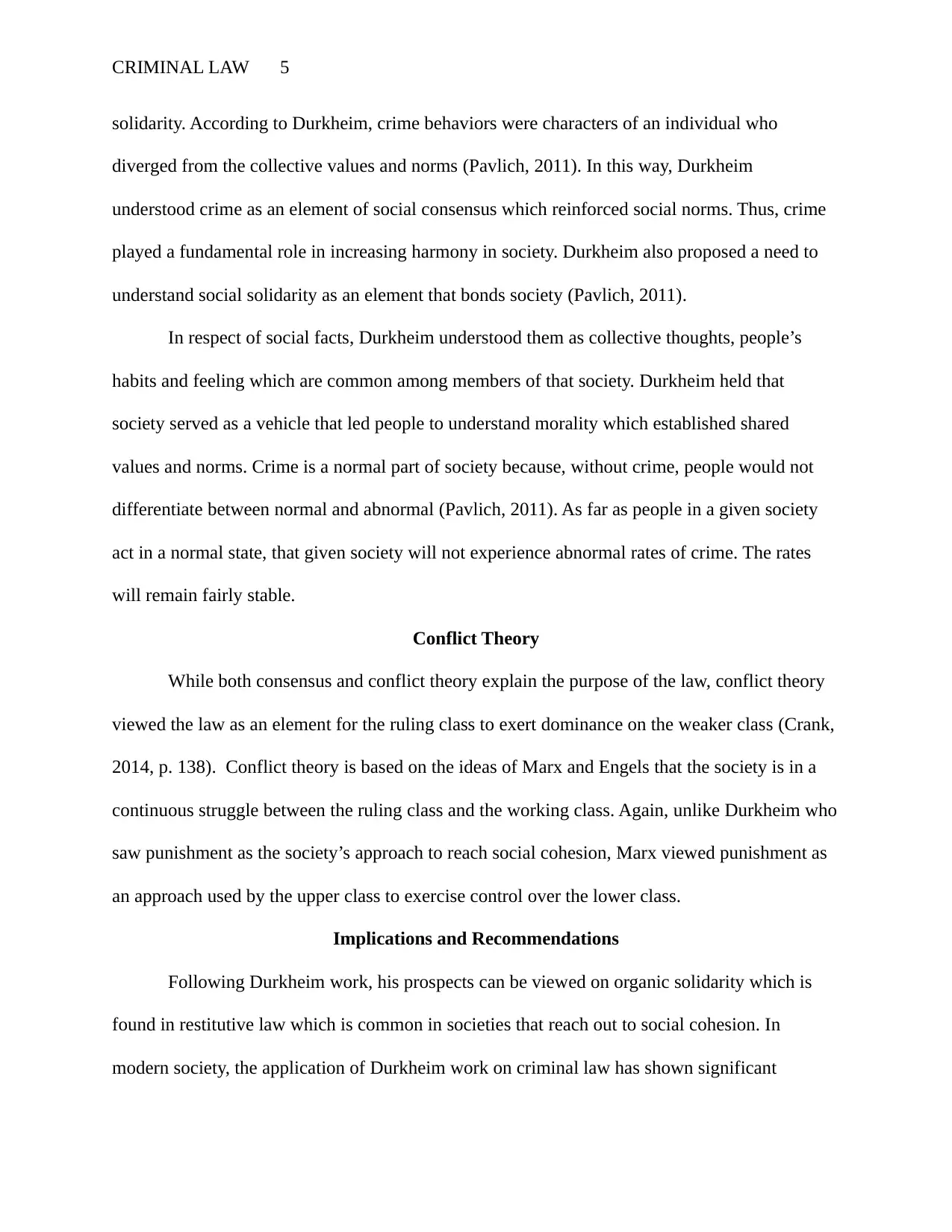
CRIMINAL LAW 5
solidarity. According to Durkheim, crime behaviors were characters of an individual who
diverged from the collective values and norms (Pavlich, 2011). In this way, Durkheim
understood crime as an element of social consensus which reinforced social norms. Thus, crime
played a fundamental role in increasing harmony in society. Durkheim also proposed a need to
understand social solidarity as an element that bonds society (Pavlich, 2011).
In respect of social facts, Durkheim understood them as collective thoughts, people’s
habits and feeling which are common among members of that society. Durkheim held that
society served as a vehicle that led people to understand morality which established shared
values and norms. Crime is a normal part of society because, without crime, people would not
differentiate between normal and abnormal (Pavlich, 2011). As far as people in a given society
act in a normal state, that given society will not experience abnormal rates of crime. The rates
will remain fairly stable.
Conflict Theory
While both consensus and conflict theory explain the purpose of the law, conflict theory
viewed the law as an element for the ruling class to exert dominance on the weaker class (Crank,
2014, p. 138). Conflict theory is based on the ideas of Marx and Engels that the society is in a
continuous struggle between the ruling class and the working class. Again, unlike Durkheim who
saw punishment as the society’s approach to reach social cohesion, Marx viewed punishment as
an approach used by the upper class to exercise control over the lower class.
Implications and Recommendations
Following Durkheim work, his prospects can be viewed on organic solidarity which is
found in restitutive law which is common in societies that reach out to social cohesion. In
modern society, the application of Durkheim work on criminal law has shown significant
solidarity. According to Durkheim, crime behaviors were characters of an individual who
diverged from the collective values and norms (Pavlich, 2011). In this way, Durkheim
understood crime as an element of social consensus which reinforced social norms. Thus, crime
played a fundamental role in increasing harmony in society. Durkheim also proposed a need to
understand social solidarity as an element that bonds society (Pavlich, 2011).
In respect of social facts, Durkheim understood them as collective thoughts, people’s
habits and feeling which are common among members of that society. Durkheim held that
society served as a vehicle that led people to understand morality which established shared
values and norms. Crime is a normal part of society because, without crime, people would not
differentiate between normal and abnormal (Pavlich, 2011). As far as people in a given society
act in a normal state, that given society will not experience abnormal rates of crime. The rates
will remain fairly stable.
Conflict Theory
While both consensus and conflict theory explain the purpose of the law, conflict theory
viewed the law as an element for the ruling class to exert dominance on the weaker class (Crank,
2014, p. 138). Conflict theory is based on the ideas of Marx and Engels that the society is in a
continuous struggle between the ruling class and the working class. Again, unlike Durkheim who
saw punishment as the society’s approach to reach social cohesion, Marx viewed punishment as
an approach used by the upper class to exercise control over the lower class.
Implications and Recommendations
Following Durkheim work, his prospects can be viewed on organic solidarity which is
found in restitutive law which is common in societies that reach out to social cohesion. In
modern society, the application of Durkheim work on criminal law has shown significant
⊘ This is a preview!⊘
Do you want full access?
Subscribe today to unlock all pages.

Trusted by 1+ million students worldwide
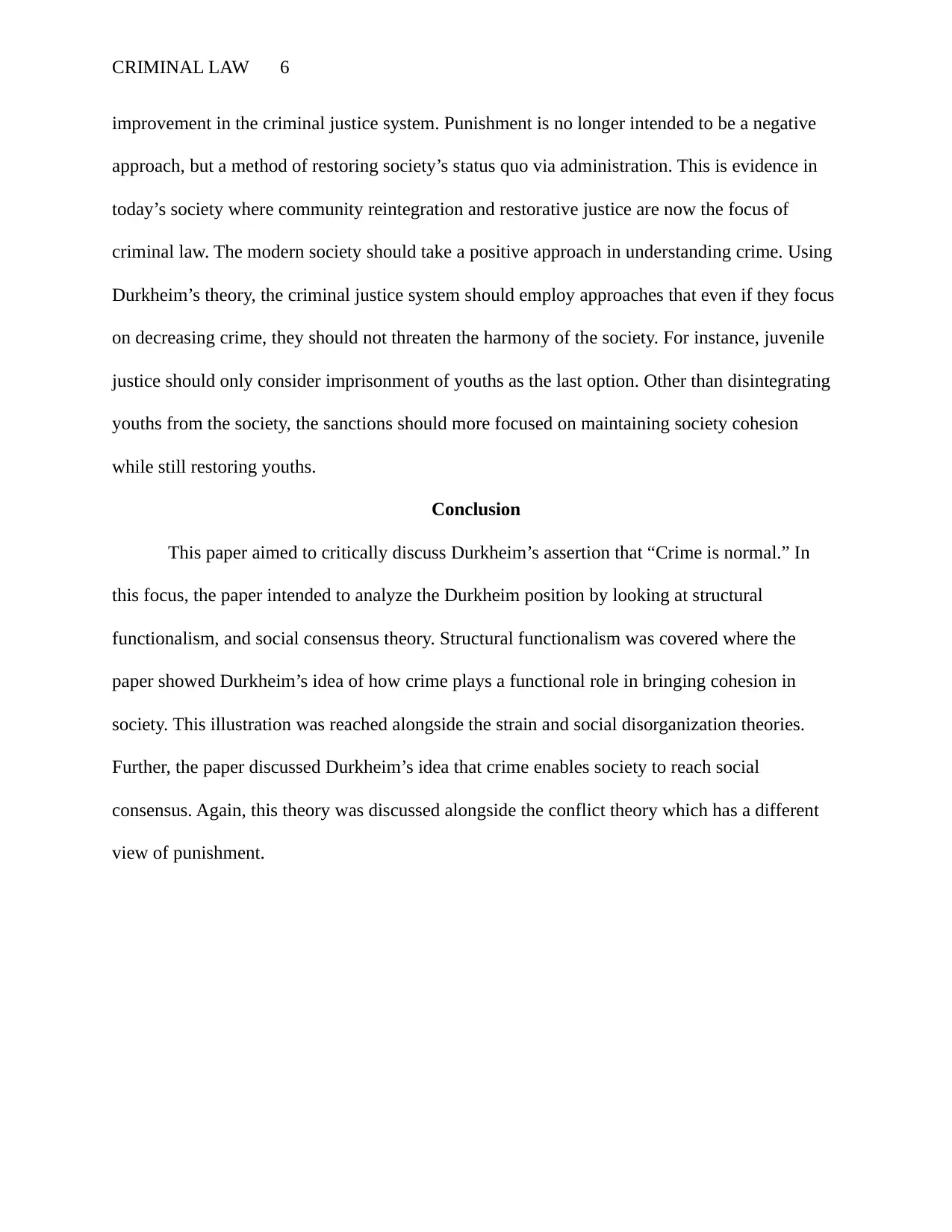
CRIMINAL LAW 6
improvement in the criminal justice system. Punishment is no longer intended to be a negative
approach, but a method of restoring society’s status quo via administration. This is evidence in
today’s society where community reintegration and restorative justice are now the focus of
criminal law. The modern society should take a positive approach in understanding crime. Using
Durkheim’s theory, the criminal justice system should employ approaches that even if they focus
on decreasing crime, they should not threaten the harmony of the society. For instance, juvenile
justice should only consider imprisonment of youths as the last option. Other than disintegrating
youths from the society, the sanctions should more focused on maintaining society cohesion
while still restoring youths.
Conclusion
This paper aimed to critically discuss Durkheim’s assertion that “Crime is normal.” In
this focus, the paper intended to analyze the Durkheim position by looking at structural
functionalism, and social consensus theory. Structural functionalism was covered where the
paper showed Durkheim’s idea of how crime plays a functional role in bringing cohesion in
society. This illustration was reached alongside the strain and social disorganization theories.
Further, the paper discussed Durkheim’s idea that crime enables society to reach social
consensus. Again, this theory was discussed alongside the conflict theory which has a different
view of punishment.
improvement in the criminal justice system. Punishment is no longer intended to be a negative
approach, but a method of restoring society’s status quo via administration. This is evidence in
today’s society where community reintegration and restorative justice are now the focus of
criminal law. The modern society should take a positive approach in understanding crime. Using
Durkheim’s theory, the criminal justice system should employ approaches that even if they focus
on decreasing crime, they should not threaten the harmony of the society. For instance, juvenile
justice should only consider imprisonment of youths as the last option. Other than disintegrating
youths from the society, the sanctions should more focused on maintaining society cohesion
while still restoring youths.
Conclusion
This paper aimed to critically discuss Durkheim’s assertion that “Crime is normal.” In
this focus, the paper intended to analyze the Durkheim position by looking at structural
functionalism, and social consensus theory. Structural functionalism was covered where the
paper showed Durkheim’s idea of how crime plays a functional role in bringing cohesion in
society. This illustration was reached alongside the strain and social disorganization theories.
Further, the paper discussed Durkheim’s idea that crime enables society to reach social
consensus. Again, this theory was discussed alongside the conflict theory which has a different
view of punishment.
Paraphrase This Document
Need a fresh take? Get an instant paraphrase of this document with our AI Paraphraser
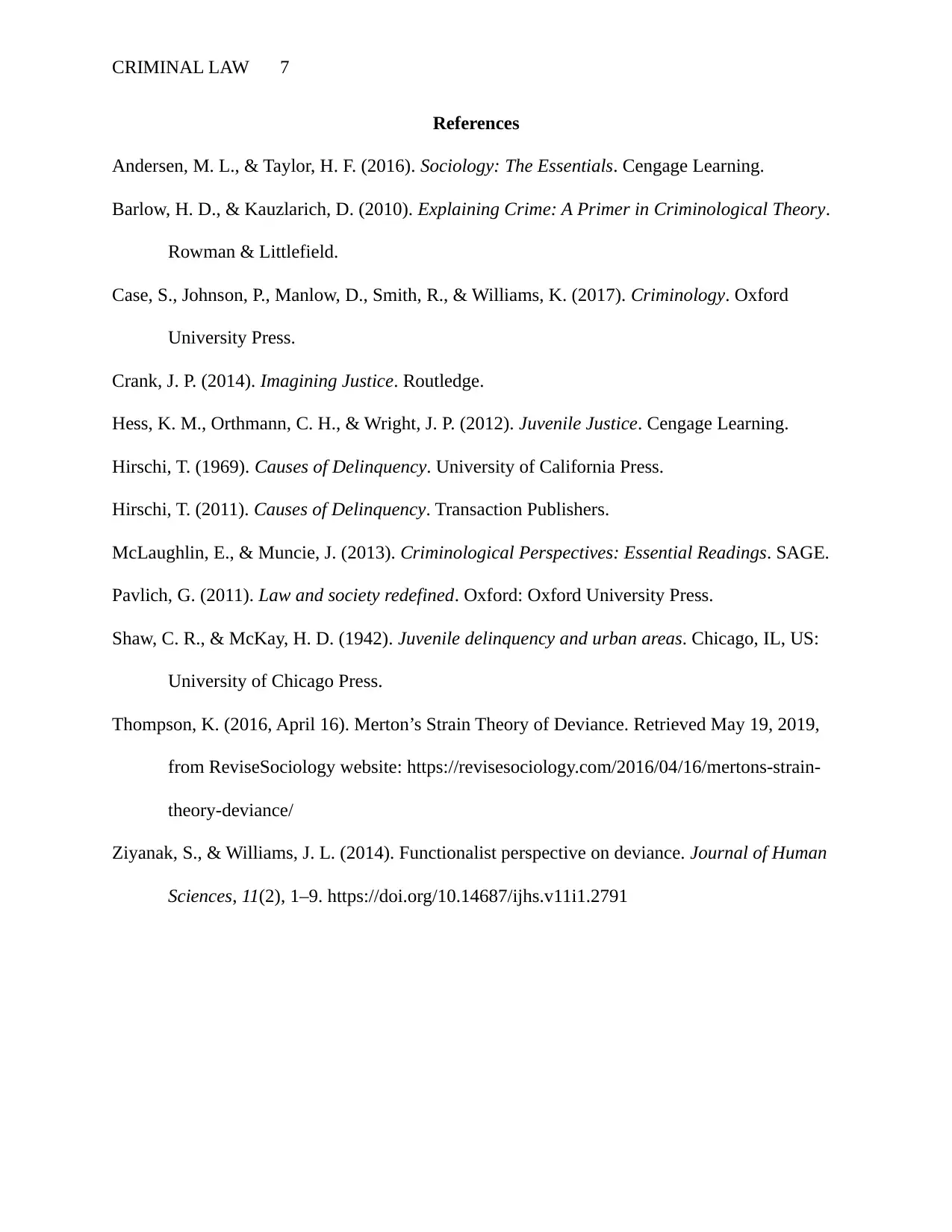
CRIMINAL LAW 7
References
Andersen, M. L., & Taylor, H. F. (2016). Sociology: The Essentials. Cengage Learning.
Barlow, H. D., & Kauzlarich, D. (2010). Explaining Crime: A Primer in Criminological Theory.
Rowman & Littlefield.
Case, S., Johnson, P., Manlow, D., Smith, R., & Williams, K. (2017). Criminology. Oxford
University Press.
Crank, J. P. (2014). Imagining Justice. Routledge.
Hess, K. M., Orthmann, C. H., & Wright, J. P. (2012). Juvenile Justice. Cengage Learning.
Hirschi, T. (1969). Causes of Delinquency. University of California Press.
Hirschi, T. (2011). Causes of Delinquency. Transaction Publishers.
McLaughlin, E., & Muncie, J. (2013). Criminological Perspectives: Essential Readings. SAGE.
Pavlich, G. (2011). Law and society redefined. Oxford: Oxford University Press.
Shaw, C. R., & McKay, H. D. (1942). Juvenile delinquency and urban areas. Chicago, IL, US:
University of Chicago Press.
Thompson, K. (2016, April 16). Merton’s Strain Theory of Deviance. Retrieved May 19, 2019,
from ReviseSociology website: https://revisesociology.com/2016/04/16/mertons-strain-
theory-deviance/
Ziyanak, S., & Williams, J. L. (2014). Functionalist perspective on deviance. Journal of Human
Sciences, 11(2), 1–9. https://doi.org/10.14687/ijhs.v11i1.2791
References
Andersen, M. L., & Taylor, H. F. (2016). Sociology: The Essentials. Cengage Learning.
Barlow, H. D., & Kauzlarich, D. (2010). Explaining Crime: A Primer in Criminological Theory.
Rowman & Littlefield.
Case, S., Johnson, P., Manlow, D., Smith, R., & Williams, K. (2017). Criminology. Oxford
University Press.
Crank, J. P. (2014). Imagining Justice. Routledge.
Hess, K. M., Orthmann, C. H., & Wright, J. P. (2012). Juvenile Justice. Cengage Learning.
Hirschi, T. (1969). Causes of Delinquency. University of California Press.
Hirschi, T. (2011). Causes of Delinquency. Transaction Publishers.
McLaughlin, E., & Muncie, J. (2013). Criminological Perspectives: Essential Readings. SAGE.
Pavlich, G. (2011). Law and society redefined. Oxford: Oxford University Press.
Shaw, C. R., & McKay, H. D. (1942). Juvenile delinquency and urban areas. Chicago, IL, US:
University of Chicago Press.
Thompson, K. (2016, April 16). Merton’s Strain Theory of Deviance. Retrieved May 19, 2019,
from ReviseSociology website: https://revisesociology.com/2016/04/16/mertons-strain-
theory-deviance/
Ziyanak, S., & Williams, J. L. (2014). Functionalist perspective on deviance. Journal of Human
Sciences, 11(2), 1–9. https://doi.org/10.14687/ijhs.v11i1.2791
1 out of 8
Related Documents
Your All-in-One AI-Powered Toolkit for Academic Success.
+13062052269
info@desklib.com
Available 24*7 on WhatsApp / Email
![[object Object]](/_next/static/media/star-bottom.7253800d.svg)
Unlock your academic potential
Copyright © 2020–2025 A2Z Services. All Rights Reserved. Developed and managed by ZUCOL.



